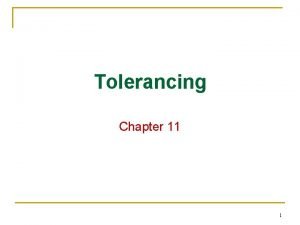Drought and Salinity Tolerance in Common Agrostis Species

- Slides: 1

Drought and Salinity Tolerance in Common Agrostis Species. Collin Ahrens and Carol Auer Department of Plant Science University of Connecticut Introduction Methods All new technologies carry both benefits and risks. For example, medical research tests the effects of new drugs before they are approved for sale. Likewise, genetically-modified plants must be assessed before they are released into the environment. Our research examines plant gene flow and the impacts from environmental release of genetically-modified plants. Plant gene flow is a natural process that occurs when pollen from one plant lands on the flower of another plant and produces a hybrid offspring. Gene flow can produce hybrid offspring with new traits that could change the ability of the plant to survive and spread. If hybrid offspring have some advantage in the environment, they could become invasive and/or affect other components of our ecosystems. Bentgrasses are widely naturalized across the U. S. due to their ability to adapt to a range of environmental conditions and stresses. A greenhouse experiment was designed to characterize the ability of four bentgrass species’ to tolerate two stresses, salinity and drought. The experiment was designed as two separate experiments (salt and drought) in a factorial randomized complete block design with three replications. In the near future, the federal government may approve the use of a genetically engineered herbicide-resistant (HR) Agrostis stolonifera. A. stolonifera (creeping bentgrass) is a common non-native grass that inhabits a myriad of environments. It is also known to hybridize with four non-native bentgrass relatives in Connecticut. If the HR A. stolonifera is used, the gene is likely to escape into feral and cultivated bentgrass populations. Studies are needed to quantify the potential impact the HR trait could have on the environment. This study uses greenhouse experiments to characterize stress tolerance in four common, feral Agrostis species. The differences in stress tolerance act as a proxy for adaptability and potential weediness. Results will be compared to observations in transect studies across different habitats in Connecticut. Figure 1. Effects of 200 m. M Na. Cl treatment. Four Agrostis species (A. stolonifera, A. capillaris, A. canina, and A. gigantea) are shown on the last day of the experiment. Treatment effects and differences between species can be seen. A. canina showed the least salt tolerance and A. capillaris showed the most salt tolerance. Control- day 21 200 m. M - day 21 Agrostis stolonifera Control- day 21 200 m. M - day 21 Agrostis canina Control- day 21 200 m. M - day 21 Agrostis capillaris Control- Day 21 200 m. M - day 21 Agrostis gigantea Seedlings of A. capillaris, A. canina, A. stolonifera, and A. gigantea were grown in 3” pots in two parts soil: one part sand: one part peat moss (2: 1: 1). The seedlings were fertilized on a biweekly basis with 20: 10: 20 until the start of the stress treatments. The following data was collected at 0, 1, 2, 7, 12, 15 and 21 days for the salt treatments and 0, 1, 2, 3, 4, 5, 10, 15, and 20 days for the drought treatments: number of ramets, fresh weight, water potential, and chlorophyll content. In the salt stress experiment, each pot was watered with 50 m. L of water twice per week with 0 m. M Na. Cl (control), 25 m. M Na. Cl, 100 m. M Na. Cl, 200 m. M Na. Cl, or 400 m. M Na. Cl. In the drought stress experiment, each pot received 50 m. L water (control), 0 m. L water, or 10 m. L water twice per week. Three un-watered plants from each species were re-watered after 10, 15 and 20 days of drought to examine re-hydration potential. It is important to note that this study is in progress and the graphs represent only one replication of the experiment. Only the results for the quantitative analysis of water potential are shown. Results and Discussion A Figure 2. Response to salt stress as measured by water potential. A) Results from four bentgrass species and five salt treatments. B) Results from 200 m. M Na. Cl salt treatment. A. capillaris plants (yellow lines) had remarkable resistance to salt stress. MPa B 200 m. M Na. CL vs. control treatments in four bentgrass species. Differences in salt and drought tolerance were observed in the greenhouse experiments with four Agrostis species. When 200 m. M Na. Cl was applied, A. canina was unable to survive more than 7 days (Figure 1). In contrast, the other Agrostis species survived 21 days of salt stress. A. capillaris plants receiving salt had the same water potential as control, suggesting a high level of tolerance for salt stress. A. gigantea and A. stolonifera behaved in a similar manner with water potential decreasing in salt stressed plants. These differences can be seen in the photographs taken on day 21 (Figure 1). The water potential data (shown) is supported by the fresh weight data (not shown). From this experiment, A. capillaris seems to be most salt tolerant while A. canina is the least tolerant. In the drought treatments, A. canina grew for only 5 days with the slow drought treatment (10 m. L water) (Figure 3 -B). A. gigantea and A. stolonifera plants died after 10 -15 days of drought. In contrast, A. capillaris plants survived to day 20 with some decrease in water potential in the drought-stressed plants. The water potential data (shown) is supported by the fresh weight data (not shown). Based on our previous field observations of feral bentgrass populations on roadsides and dry sites, we expected A. gigantea to demonstrate the highest level of stress tolerance. However, this greenhouse experiment suggests that A. capillaris may be more tolerant of drought and salt stress than A. gigantea. The experiment will be repeated to provide a better picture of the adaptability of A. capillaris compared to other feral bentgrass species. Figure 3. Response to water deficits. A) Comparison of two drought treatments, B) Comparison of control (watered) vs. slow drought treatment. A. canina, A. stolonifera and A. gigantea plants died by day 15. Only A. capillaris plants survived to day 20. B A

